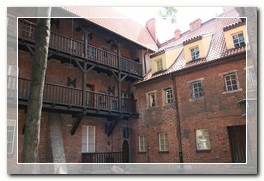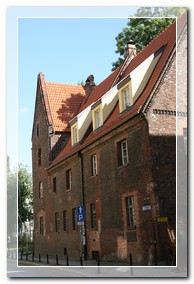


 The former city prison was built in the XIII century,
and the first record about it comes from 1450. It's present shape is a
result of reconstructions, which took place in XVI and XVII century. The
oldest part of the building is the XIV century northern wing, formerly
containing a chapel. The remaining wings were added around the year
1500. In the half of the XVI century the south wing was built. It
contained workshops of female prisoners kept in the western wing. The
cellar part of the northern wing are former main rooms of the prison for
people, who were born in poor families and for dangerous criminals
punished with the traditional one
The former city prison was built in the XIII century,
and the first record about it comes from 1450. It's present shape is a
result of reconstructions, which took place in XVI and XVII century. The
oldest part of the building is the XIV century northern wing, formerly
containing a chapel. The remaining wings were added around the year
1500. In the half of the XVI century the south wing was built. It
contained workshops of female prisoners kept in the western wing. The
cellar part of the northern wing are former main rooms of the prison for
people, who were born in poor families and for dangerous criminals
punished with the traditional one  year and 6 Sundays jail. The bottom hall, which one
can sightsee, because the club "Pracoffnia" is situated there today, was
probably designed for rich people and important personas. In the eastern
part of the undergrounds, opposite the entry to the courtyard, there was
the room of examinations and tortures also occupied today by the club.
In 1733 the building could hold up to hundred prisoners. Among the
famous figures, who sat out here their sentences, it is worth to mention
Wit Stwosz. The sculptor, accused of forging a bill, spent here a whole
year. The municipality stopped used the building as a prison in 1818.
Philanthropical institutions and a pawnshop were situated here later.
Today, it is the seat of Wroclaw's Institute of Archaeology and
Ethnology of the Polish Academy of Sciences.
year and 6 Sundays jail. The bottom hall, which one
can sightsee, because the club "Pracoffnia" is situated there today, was
probably designed for rich people and important personas. In the eastern
part of the undergrounds, opposite the entry to the courtyard, there was
the room of examinations and tortures also occupied today by the club.
In 1733 the building could hold up to hundred prisoners. Among the
famous figures, who sat out here their sentences, it is worth to mention
Wit Stwosz. The sculptor, accused of forging a bill, spent here a whole
year. The municipality stopped used the building as a prison in 1818.
Philanthropical institutions and a pawnshop were situated here later.
Today, it is the seat of Wroclaw's Institute of Archaeology and
Ethnology of the Polish Academy of Sciences.






